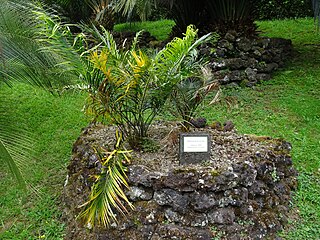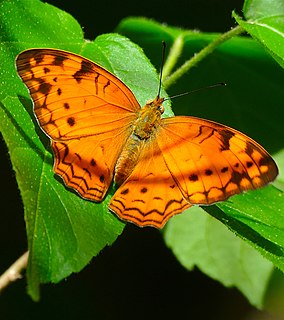
The International Union for Conservation of Nature (IUCN) Red List of Threatened Species, founded in 1964, is the world's most comprehensive inventory of the global conservation status of biological species. It uses a set of precise criteria to evaluate the extinction risk of thousands of species and subspecies. These criteria are relevant to all species and all regions of the world. With its strong scientific base, the IUCN Red List is recognized as the most authoritative guide to the status of biological diversity. A series of Regional Red Lists are produced by countries or organizations, which assess the risk of extinction to species within a political management unit.

The red-chested swallow is a small non-migratory passerine bird found in West Africa, the Congo Basin and Ethiopia. It has a long, deeply forked tail and curved, pointed wings.

Cauliflory is a botanical term referring to plants that flower and fruit from their main stems or woody trunks, rather than from new growth and shoots. This can allow trees to be pollinated or have their seeds dispersed by animals that climb on trunks and sturdy limbs to feed on the nectar and fruits. Plants may instead have fruit which drop from the canopy and ripen only after they reach the ground, an alternative "strategy" to cauliflory.

Gymnanthes lucida, commonly known as shiny oysterwood or crabwood, is a species of flowering plant in the spurge family, Euphorbiaceae, that is native to southern Florida in the United States, the Bahamas, the Caribbean, Mexico, and Central America.
Podocarpus hispaniolensis is a species of conifer in the family Podocarpaceae. It is endemic to the Dominican Republic.
Alphonsea lucida is a species of plant in the family Annonaceae. It is endemic to Peninsular Malaysia.
Klarobelia lucida is a species of plant in the Annonaceae family. It is endemic to Ecuador. Its natural habitat is subtropical or tropical dry forests. It is threatened by habitat loss.

Macrozamia lucida is a species of plant in the family Zamiaceae. It is endemic to Australia.
Meryta lucida is a species of plant in the family Araliaceae. It is endemic to French Polynesia.
Parashorea lucida is a species of plant in the family Dipterocarpaceae. The name lucida is derived from Latin and refers to the venation on the leaf. It is a tall emergent tree, up to 60 m tall, found in mixed dipterocarp forest on clay and clay soils. It is found in Sumatra and Borneo. It is threatened by habitat loss.
Rawsonia burtt-davyi is a species of plant in the Achariaceae family. It is endemic to Malawi.
Tristaniopsis lucida is a species of plant in the family Myrtaceae. It is endemic to New Caledonia.

Cymothoe caenis, the common glider, is a species of butterfly of the family Nymphalidae. It is found in Guinea, Sierra Leone, Liberia, Ivory Coast, Ghana, Togo, southern Nigeria, Cameroon, the Republic of the Congo, the Central African Republic, Angola, the Democratic Republic of the Congo, Uganda, Tanzania and Zambia. The habitat consists of forests and heavy woodland. It is a migratory species.
As of July 2016, the International Union for Conservation of Nature (IUCN) lists 238 conservation dependent species. 0.29% of all evaluated species are listed as conservation dependent. The IUCN also lists seven subspecies and five varieties as conservation dependent.
Acraea boopis, the rainforest acraea, is a butterfly of the family Nymphalidae. It is found in KwaZulu-Natal, Swaziland, from Mozambique to Kenya and in Tanzania.

Lachnoptera ayresii, the eastern blotched leopard, is a butterfly of the family Nymphalidae. It is found in Afromontane and riverine forest from Port St. Johns in the Eastern Cape and then along the escarpment to the midlands of KwaZulu-Natal, Swaziland, Mpumalanga and the Wolkberg in Limpopo, north to Zimbabwe and Mozambique.

Lachnoptera anticlia, the western blotched leopard, is a butterfly in the family Nymphalidae. It is found in Senegal, Guinea, Sierra Leone, Liberia, Ivory Coast, Ghana, Togo, Nigeria, Cameroon, Equatorial Guinea, Gabon, the Republic of the Congo, the Central African Republic, Angola, the Democratic Republic of the Congo, southern Sudan, Uganda, western Kenya, north-western Tanzania and north-western Zambia. The habitat consists of forests and forest margins.
Cymothoe cottrelli is a butterfly in the family Nymphalidae. It is found in Tanzania, Malawi and Zambia. The habitat consists of forests.
Cymothoe vumbui, the Vumba glider, is a butterfly in the family Nymphalidae. It is found in eastern Zimbabwe and Mozambique. The habitat consists of montane forests.
Poeciliopsis lucida, the clearfin livebearer, is a species of small freshwater fish in the family Poeciliidae. Reproduction is viviparous, and the female can have several clutches of young developing internally at the same time. It is one of several species of small livebearing fish endemic to Mexico that were described in 1960 by the American ichthyologist Robert Rush Miller.









